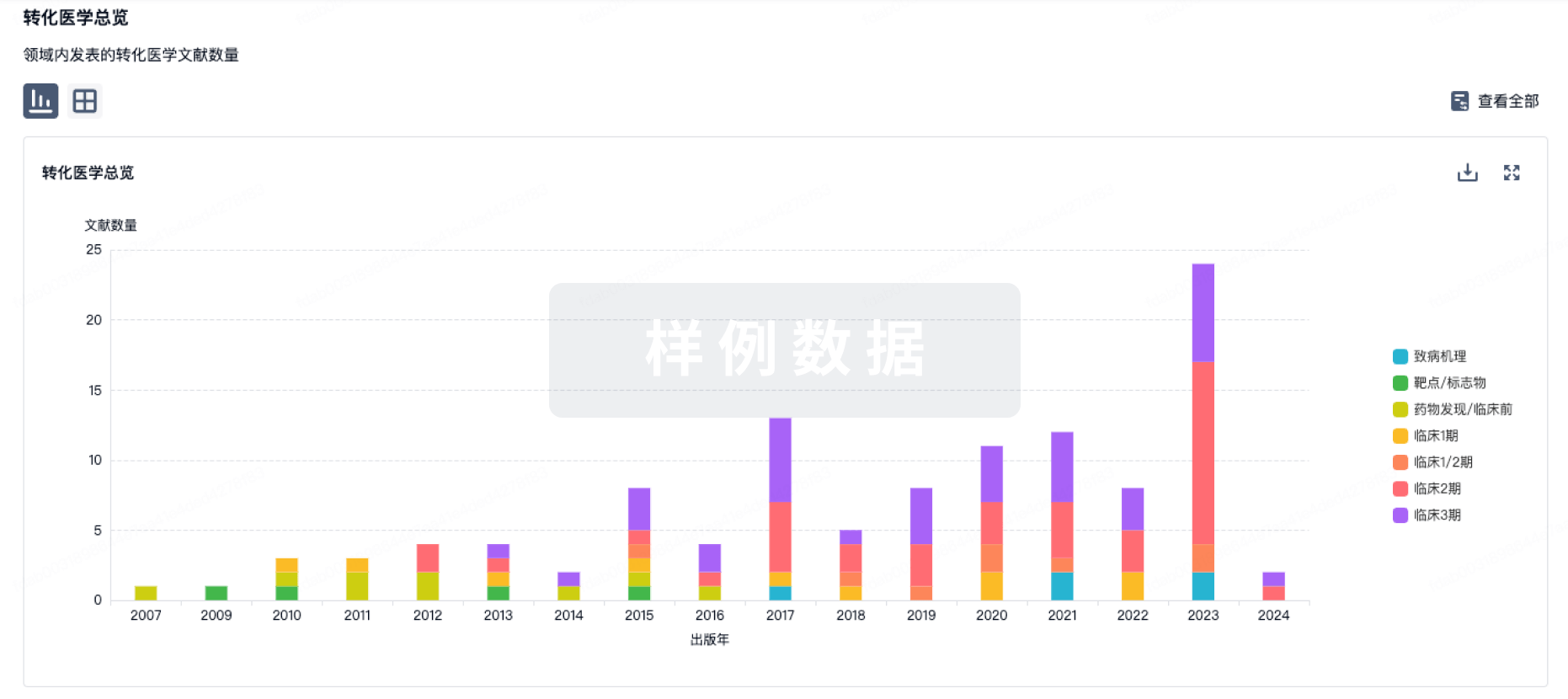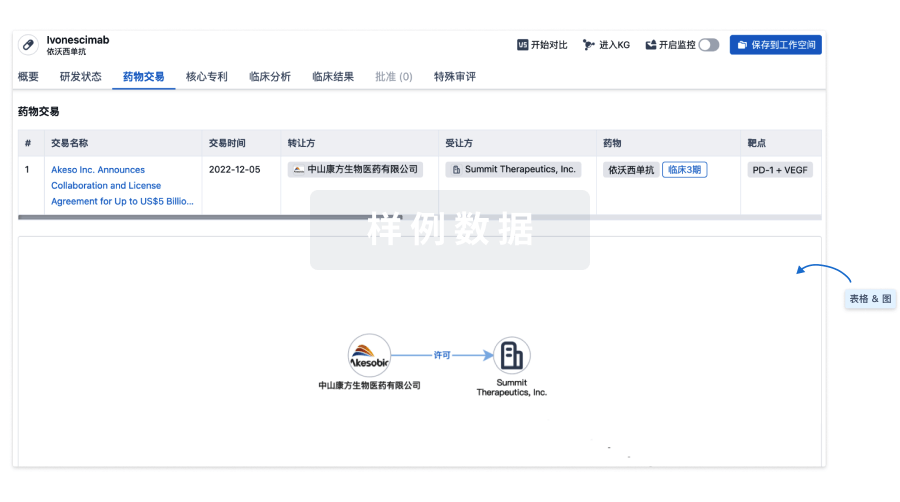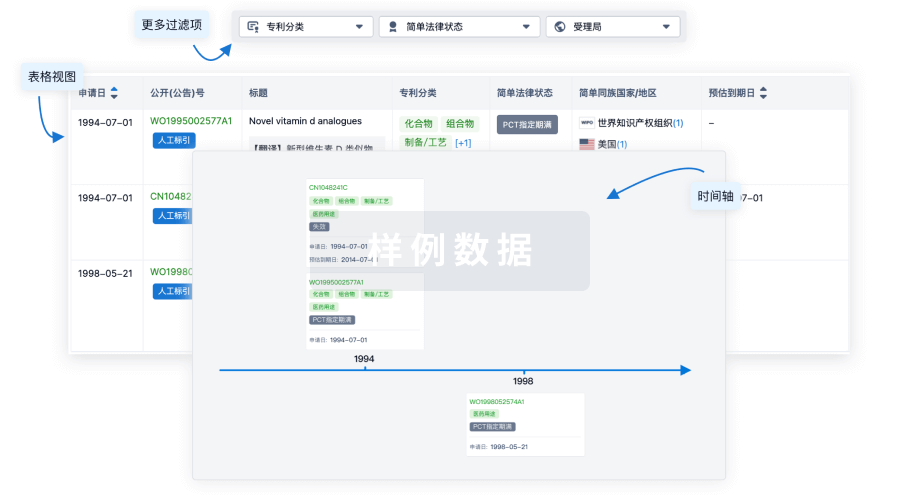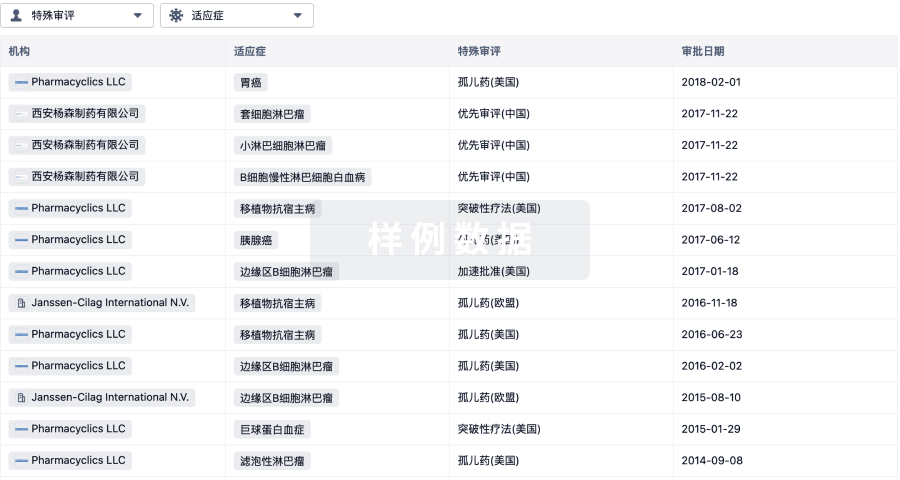预约演示
更新于:2025-05-15
Pentetate Calcium Trisodium
喷替酸钙钠
更新于:2025-05-15
概要
基本信息
权益机构- |
最高研发阶段批准上市 |
首次获批日期 美国 (2004-08-11), |
最高研发阶段(中国)批准上市 |
特殊审评- |
登录后查看时间轴
结构/序列
分子式C14H18CaN3Na3O10 |
InChIKeyAYFCVLSUPGCQKD-UHFFFAOYSA-I |
CAS号12111-24-9 |
关联
3
项与 喷替酸钙钠 相关的临床试验NCT05359835
DTPA Chelation for Symptoms After Gadolinium-assisted MRI
The study aims at gathering additional data on the safety and effectiveness of using intravenous administration of the drugs Ca-DTPA/Zn-DTPA to remove the heavy metal gadolinium from the bodies of patients who have retained it and developed symptoms of Gadolinium Deposition Disease following an MRI in which a gadolinium-containing contrast agent was utilized. The outcome data will include measures of symptom relief after as many as six paired Calcium-DTPA/Zinc-DTPA chelation treatments. The study also aims at gathering additional data before and after DTPA treatment regarding levels of certain cytokines in the patients' blood that have been reported to be abnormally elevated in patients with retained gadolinium.
开始日期2023-04-11 |
申办/合作机构 |
NCT02947022
Investigator Initiated Investigational New Drug Application to Study the Effects of IV-Administered Ca-DTPA and Zn-DTPA To Treat Patients With Gadolinium Deposition Disease
Purpose: There are two goals we have for this prospective single arm study; to see an increase in the amount of gadolinium in 24 hour urine collection following each infusion treatment with Calcium and Zinc DTPA, and to see a reduction or elimination of gadolinium deposition disease (GDD) symptoms.
Participants: Twenty (20) patients who are suffering from gadolinium deposition disease (GDD)
Procedures: Over a series of three (3) treatment time-points patients will be treated with IV Ca-DTPA on day one, and Zn-DTPA on day two.
Participants: Twenty (20) patients who are suffering from gadolinium deposition disease (GDD)
Procedures: Over a series of three (3) treatment time-points patients will be treated with IV Ca-DTPA on day one, and Zn-DTPA on day two.
开始日期2016-10-01 |
申办/合作机构 |
NCT00001575
Anti-Tac(90 Y-HAT) to Treat Hodgkin's Disease, Non-Hodgkin's Lymphoma and Lymphoid Leukemia
This study will examine the use of a radioactive monoclonal antibody called yttrium 90-labeled humanized anti-Tac (90 Y-HAT) for treating certain cancers. Monoclonal antibodies are genetically engineered proteins made in large quantities and directed against a specific target in the body. The anti-Tac antibody in this study is targeted to tumor cells and is tagged (labeled) with a radioactive substance called Yttrium-90 (Y-90). The study will determine the maximum tolerated dose of 90Y-HAT and examine its safety and effectiveness.
Patients 18 years of age and older with Hodgkin's disease, non-Hodgkin's lymphoma and lymphoid leukemia who have proteins on their cancer cells that react with anti-Tac may be eligible for this study. Candidates are screened with a medical history and physical examination, blood and urine tests, electrocardiogram (EKG), chest x-ray, computed tomography (CT) scan or ultrasound of the abdomen, positron emission tomography (PET) scan of the neck and body, and skin test for immune reactivity to antigens (similar to skin tuberculin test).
Before beginning treatment, participants may undergo additional procedures, including the following:
Patients with suspicious skin lesions have a skin biopsy. An area of skin is numbed and a circular piece of skin about 1/4-inch diameter is removed with a cookie cutter-like instrument.
Patients with hearing loss have a hearing test.
Patients with neurological symptoms have a lumbar puncture (spinal tap). A local anesthetic is given and a needle is inserted in the space between the bones in the lower back where the cerebrospinal fluid circulates below the spinal cord. A small amount of fluid is collected through the needle.
Patients who have not had a bone marrow biopsy within 6 months of screening also undergo this procedure. The skin and bone at the back of the hip are numbed with a local anesthetic and a small piece of bone is withdrawn through a needle.
Patients receive 90 Y-HAT in escalating doses to determine the highest dose that can be safely given. The first group of three patients receives a low dose and, if there are no significant side effects at that dose, the next three patients receive a higher dose. This continues with subsequent groups until the maximum study dose is reached. 90 Y-HAT is given through a vein (intravenous (IV)) over a 2-hour period. In addition, a drug called Pentetate Calcium Trisodium Inj (Ca-DTPA) is given via IV over 5 hours for 3 days to help reduce the side effects of the 90Y-HAT. In some patients, the 90 Y-HAT may also be attached to a radioactive metal called Indium-111 to monitor what happens to the injected material. During infusion of the drug, patients undergo PET scanning to trace the path of the injected material in the body. For this procedure, the patient lies in the scanner, remaining in one position during the entire infusion.
Blood and urine specimens are collected periodically over a 6-week period following the infusion to determine the level of the radioactive antibody. Bone marrow, lymph node, or skin biopsies may be done to determine how much of the antibody entered these sites. Patients whose disease remains stable or improves with therapy may receive up to six more infusions of 90 Y-HAT, with at least a 6-week interval between treatments.
Patients 18 years of age and older with Hodgkin's disease, non-Hodgkin's lymphoma and lymphoid leukemia who have proteins on their cancer cells that react with anti-Tac may be eligible for this study. Candidates are screened with a medical history and physical examination, blood and urine tests, electrocardiogram (EKG), chest x-ray, computed tomography (CT) scan or ultrasound of the abdomen, positron emission tomography (PET) scan of the neck and body, and skin test for immune reactivity to antigens (similar to skin tuberculin test).
Before beginning treatment, participants may undergo additional procedures, including the following:
Patients with suspicious skin lesions have a skin biopsy. An area of skin is numbed and a circular piece of skin about 1/4-inch diameter is removed with a cookie cutter-like instrument.
Patients with hearing loss have a hearing test.
Patients with neurological symptoms have a lumbar puncture (spinal tap). A local anesthetic is given and a needle is inserted in the space between the bones in the lower back where the cerebrospinal fluid circulates below the spinal cord. A small amount of fluid is collected through the needle.
Patients who have not had a bone marrow biopsy within 6 months of screening also undergo this procedure. The skin and bone at the back of the hip are numbed with a local anesthetic and a small piece of bone is withdrawn through a needle.
Patients receive 90 Y-HAT in escalating doses to determine the highest dose that can be safely given. The first group of three patients receives a low dose and, if there are no significant side effects at that dose, the next three patients receive a higher dose. This continues with subsequent groups until the maximum study dose is reached. 90 Y-HAT is given through a vein (intravenous (IV)) over a 2-hour period. In addition, a drug called Pentetate Calcium Trisodium Inj (Ca-DTPA) is given via IV over 5 hours for 3 days to help reduce the side effects of the 90Y-HAT. In some patients, the 90 Y-HAT may also be attached to a radioactive metal called Indium-111 to monitor what happens to the injected material. During infusion of the drug, patients undergo PET scanning to trace the path of the injected material in the body. For this procedure, the patient lies in the scanner, remaining in one position during the entire infusion.
Blood and urine specimens are collected periodically over a 6-week period following the infusion to determine the level of the radioactive antibody. Bone marrow, lymph node, or skin biopsies may be done to determine how much of the antibody entered these sites. Patients whose disease remains stable or improves with therapy may receive up to six more infusions of 90 Y-HAT, with at least a 6-week interval between treatments.
开始日期1997-04-01 |
申办/合作机构 |
100 项与 喷替酸钙钠 相关的临床结果
登录后查看更多信息
100 项与 喷替酸钙钠 相关的转化医学
登录后查看更多信息
100 项与 喷替酸钙钠 相关的专利(医药)
登录后查看更多信息
420
项与 喷替酸钙钠 相关的文献(医药)2025-03-01·JOURNAL OF RADIOLOGICAL PROTECTION
Optimizing Ca-DTPA/Zn-DTPA therapy for internal decorporation: transitioning from intravenous to oral route with insights on safety and toxicity
Review
作者: Sharma, Pooja ; Mahar, Riya ; Sandal, Nidhi
Abstract:
Ca-DTPA and Zn-DTPA are the decorporating agents approved by the USFDA for removing plutonium, americium, or curium from the subjects known or suspected to be contaminated with these radionuclides. Ca-DTPA and Zn-DTPA are well-known chelating agents with a strong affinity for many bivalent, trivalent, and certain tetravalent metal ions, including plutonium (Pu+4) and thorium (Th+4). The major problem associated with Ca-DTPA and Zn-DTPA therapy is that the only approved route of administration is intravenous or inhalation due to its extremely poor bioavailability. Both these drugs belong to BCS class III drugs with high solubility and low permeability. Researchers are exploring various approaches to make these drugs bioavailable via alternate routes, especially the oral route. This will enable pre-hospital care, better patient compliance, and minimize its clinically significant side effect of electrolyte imbalance. The present paper highlights the practical feasibility and challenges of establishing an oral route for delivering Ca-DTPA and Zn-DTPA with the research around it. Also, the paper highlights the importance of establishing an oral dose and the dosing schedule for Ca-DTPA and Zn-DTPA before plunging into its formulation development. These advancements underline the potential of orally administered chelating agents and alternative delivery methods in addressing the limitations of current intravenous formulations and improving accessibility and patient outcomes.
2025-02-01·SCIENCE OF THE TOTAL ENVIRONMENT
Impact of DTPA and 3,4,3-LI(1,2-HOPO) on EuIII interactions with renal cells in vitro
Article
作者: Senwitz, Christian ; Drobot, Björn ; Heller, Anne ; Vogel, Manja ; Stumpf, Thorsten
This study represents a first comprehensive investigation on how the decorporation agents CaNa3-DTPA (DTPA) and 3,4,3-LI(1,2-HOPO) (LIHOPO) affect EuIII interactions with human and rat kidney cells in vitro. Cell biological investigations were complemented with physicochemical measurements to correlate cytotoxic impairments with intracellular metal uptake and EuIII speciation. Upon exposure to sole DTPA or LIHOPO, cell viability and morphology are affected in a time- and concentration-dependent manner. For both decorporation agents, detailed EC50 values for renal cells in vitro are reported. Simultaneous application of EuIII + DTPA in the medium leads to formation of the soluble and largely cell impermeable EuDTPA2- complex. At ligand excess, this significantly reduces intracellular EuIII uptake. However, EuDTPA2- was spectroscopically detected also inside cells indicating that small fractions of this complex are able to pass the plasma membrane. When EuIII + LIHOPO is applied to the medium, the soluble EuLIHOPO- complex is formed. In contrast to DTPA, this drastically enhances intracellular EuIII uptake even at ligand deficit demonstrating that EuLIHOPO- is highly cell permeable. Concomitantly, this complex was spectroscopically detected inside cells confirming its plasma membrane passage and intracellular stability. Nevertheless, due to stable EuIII binding, the cell viability is not influenced by the increased intracellular EuIII content. In fact, the applied ligand concentration is much more critical in this regard, emphasizing the need for cytotoxic investigations. Our results improve the knowledge of the cellular interactions of lanthanides ± decorporation agents and demonstrate the combination of in vitro cell culture and spectroscopy being a sophisticated toolbox for this.
2025-02-01·JOURNAL OF RADIOANALYTICAL AND NUCLEAR CHEMISTRY
Parameters affecting skin decontamination using wet reagents
作者: Khan, Zahid ; Toor, Arshad ; Semmler, Jaleh
Abstract: This paper reports the results of tests performed to evaluate the effects of key parameters on the effectiveness of several wet decontamination processes for removal of 60Co, 137Cs and 241Am from pig skin.Parameters tested included decontamination reagent composition, radionuclide deposition solution composition, the time between contamination and decontamination, and skin thickness and moisture content.Gamma-spectroscopy was used to determine the percentage activity removed and to quantify radionuclide permeation.The composition of the solution used for radionuclide deposition affected radionuclide removal, especially 241Am.Radionuclide permeation showed a strong effect of skin hydration; 137Cs permeated quickly through the samples while 241Am showed no permeation.
3
项与 喷替酸钙钠 相关的新闻(医药)2023-09-24
·药闻康策
☝ 点击上方 一键预约 ☝ 最新最热的医药健康新闻政策当前国际形势下人们谈“核”色变。世卫组织2023年1月27日就发布了应对辐射和核紧急情况建议储备的药物清单,这是自2007年以来的首次更新。本文根据此出版物,以及相关指南、文献,盘点了6大类核辐射应急药品,以及优缺点、用药剂量、禁忌,供大家参考。注:本文仅作信息交流之目的,文中观点不代表药智网立场,也不是治疗方案推荐。如需获得治疗方案指导,请前往正规医院就诊。表1 世卫组织罗列、典型的辐射应急储备清单01氨巯基类氨巯基类化合物是效果较好的一类辐射防护剂。代表药物:(1)半胱胺是研究最早的含氨巯基防护剂,临床静脉注射给药,可以减轻放射反应,但此药有有效防护期短、毒性大、口服效果差、在空气中不稳定等缺点。(2)氨磷汀(阿米福汀,WR-2721)是美国Water Reed陆军医学研究所推出的辐射防护剂,也是FDA许可的第一个辐射防护剂,是目前公认的防护效果很好的药物,对较大剂量全身照射有明显预防效果,能减轻辐射导致的食管炎、肺炎和骨髓抑制。缺点是有效用药量较大,毒副反应严重。研究还发现,在γ和中子照射前使用氨磷汀可降低癌变和突变的发生。因此,美国国土安全部在核应急医学准备和响应中建议,初始响应人员在进入放射性爆炸区域前服用氨磷汀,以降低随机效应的发生[1]。02激素类激素类药物是一类重要的辐射防护剂,通过与相应受体结合而发挥作用,具有抗炎、抗肿瘤、抗氧化、清除自由基等功能。在体内通过修复机体的血液系统和免疫系统来发挥抗辐射损伤的作用。常见的具有辐射损伤防护作用的激素类药物包括甾族类化合物、褪黑素等。天然甾体激素(如雌二醇)或人工合成的非甾体激素(如己烷雌酚、己烯雌酚等)在临床和动物实验中都显示有一定程度的辐射防护作用,辐射前后给药都有效果。(1)尼尔雌醇是雌三醇的长效制剂,对照射导致的造血系统损伤有明显的保护作用;(2)目前,一种称为5-雄甾烯二醇(5-AED)的类固醇药物,引起了人们关注,该药物化学性质稳定,毒性较低,能明显提高全身辐射小鼠和猕猴的存活率,促进辐射后造血功能恢复以及造血生长因子的表达。美军放射生物学研究所(AFRRI)已将(5-AED)列入候选辐射防护药物进行重点研究[1]。03阻吸收剂阻吸收剂是使特定组织中的稳定元素代谢处于饱和后降低相应的放射性核素摄入的一种制剂。稳定碘可以阻滞放射性碘通过Na-I转运体的载体介导转运而在甲状腺中浓缩,甲状腺被稳定碘饱和并封闭甲状腺。稳定性碘目前主要有2种,一种为碘化钾(KI),另一种为碘酸钾(KIO3),两者对放射性碘阻吸收的作用基本相同。WHO也将其列入使用指南,事故后及时给予KI治疗是相对安全有效的。KI的推荐剂量取决于年龄(表2),通常单次给药,但如果长时间重复暴露或无法撤离,则可以重复给予稳定碘。稳定碘的最佳给药时间是暴露前24h内和暴露后2h内。稳定碘储存时间较长,在干燥阴凉的地方,可保存5年,之后需测量其碘含量,可适当延长保质期[2]。表2 不同年龄的碘化钾推荐给药量04螯合剂放射性核素导致体内污染后,不同的核素会蓄积于靶器官,从而对机体造成放射性损伤,可以使用螯合剂与含有重金属离子的化合物结合形成络合物,从而清除体内的放射性核素。普鲁士蓝普鲁士蓝即亚铁氰化铁,口服后肠道不吸收,在肠道内选择性地与摄入的或由肠道腺体再分泌的铯/铊相结合,形成稳定的亚铁氰化铯盐,由粪便排出。国外孤儿药指定剂量为:成人和青少年每次3g口服,每日3次,最少持续30天;儿童(2~12岁)每次1g口服,每日3次,最少持续30天;二者均需根据每周测量尿液和分辨放射性来确定疗程。需注意的是有习惯性便秘者和活动性消化道溃疡或出血者应慎用或禁用。Zn-DTPA和Ca-DTPA二乙烯三胺五乙酸三钠锌(Zn-DTPA)和二乙烯三胺五乙酸三钠钙(Ca-DTPA)能加快钍、钚及稀土元素等放射性核素从尿中排放,在中毒晚期仍有一定效果,但不能用于放射碘、铀和镎的促排。Zn-DTPA和Ca-DTPA不能同时使用,FDA推荐首选Ca-DTPA,如需额外治疗,则转用Zn-DTPA持续治疗。如果是多种方式导致体内污染,则静脉滴注方式效果更好。治疗持续的时间可根据体内污染程度和患者对治疗的反应来确定。在治疗过程中应每周检测污染水平以确定是否终止治疗。肾病综合征或肾功能不全患者禁用Ca-DTPA。由于Ca-DTPA具有致畸性,因此在怀孕期间仅给予Zn-DTPA[3]。褐藻酸钠褐藻酸钠在胃肠道内基本不吸收,可与锶、镭和钡形成稳定的复合物,主要用于这些核素,特别是放射性锶体内污染。一般制成2%褐藻酸钠糖浆、3%饼干或6%面包。需在事故后42h内服用,10g/次。05细胞因子急性放射病主要表现为造血系统综合征,根据暴露的严重程度,可能进一步发展为胃肠道、心血管和神经系统的损伤。造血系统损伤治疗的首选产品主要包括细胞因子-生长因子,不仅有放射防护作用,而且能诱导骨髓干细胞增殖、分化,促进造血功能的恢复[4](见表3)。表3 常见细胞因子抗辐射损伤的作用机制06天然药物表4列举了部分具有抗辐射保护作用的单味中药,同时汇总了其有效成分及其发挥抗辐射保护的作用机制[4]。表4 常见的具有抗辐射损伤作用的单味中药(来源:药智网 作者:吕鑫)药闻康策新媒体矩阵微信公众号点击下方 一键关注 【免责声明】1.“药闻康策”部分文章信息来源于网络转载是出于传递更多信息之目的,并不意味着赞同其观点或证实其内容的真实性。如对内容有疑议,请及时与我司联系。2.“药闻康策”致力于提供合理、准确、完整的资讯信息,但不保证信息的合理性、准确性和完整性,且不对因信息的不合理、不准确或遗漏导致的任何损失或损害承担责任。3.“药闻康策”所有信息仅供参考,不做任何商业交易或医疗服务的根据,如自行使用“药闻康策”内容发生偏差,我司不承担任何责任,包括但不限于法律责任,赔偿责任。欢迎转发分享、收藏、点赞、点在看
放射疗法诊断试剂
2023-09-23
·药智网
当前国际形势下人们谈“核”色变。世卫组织2023年1月27日就发布了应对辐射和核紧急情况建议储备的药物清单,这是自2007年以来的首次更新。本文根据此出版物,以及相关指南、文献,盘点了6大类核辐射应急药品,以及优缺点、用药剂量、禁忌,供大家参考。注:本文仅作信息交流之目的,文中观点不代表药智网立场,也不是治疗方案推荐。如需获得治疗方案指导,请前往正规医院就诊。表1 世卫组织罗列、典型的辐射应急储备清单01氨巯基类氨巯基类化合物是效果较好的一类辐射防护剂。代表药物:(1)半胱胺是研究最早的含氨巯基防护剂,临床静脉注射给药,可以减轻放射反应,但此药有有效防护期短、毒性大、口服效果差、在空气中不稳定等缺点。(2)氨磷汀(阿米福汀,WR-2721)是美国Water Reed陆军医学研究所推出的辐射防护剂,也是FDA许可的第一个辐射防护剂,是目前公认的防护效果很好的药物,对较大剂量全身照射有明显预防效果,能减轻辐射导致的食管炎、肺炎和骨髓抑制。缺点是有效用药量较大,毒副反应严重。研究还发现,在γ和中子照射前使用氨磷汀可降低癌变和突变的发生。因此,美国国土安全部在核应急医学准备和响应中建议,初始响应人员在进入放射性爆炸区域前服用氨磷汀,以降低随机效应的发生[1]。02激素类激素类药物是一类重要的辐射防护剂,通过与相应受体结合而发挥作用,具有抗炎、抗肿瘤、抗氧化、清除自由基等功能。在体内通过修复机体的血液系统和免疫系统来发挥抗辐射损伤的作用。常见的具有辐射损伤防护作用的激素类药物包括甾族类化合物、褪黑素等。天然甾体激素(如雌二醇)或人工合成的非甾体激素(如己烷雌酚、己烯雌酚等)在临床和动物实验中都显示有一定程度的辐射防护作用,辐射前后给药都有效果。(1)尼尔雌醇是雌三醇的长效制剂,对照射导致的造血系统损伤有明显的保护作用;(2)目前,一种称为5-雄甾烯二醇(5-AED)的类固醇药物,引起了人们关注,该药物化学性质稳定,毒性较低,能明显提高全身辐射小鼠和猕猴的存活率,促进辐射后造血功能恢复以及造血生长因子的表达。美军放射生物学研究所(AFRRI)已将(5-AED)列入候选辐射防护药物进行重点研究[1]。03阻吸收剂阻吸收剂是使特定组织中的稳定元素代谢处于饱和后降低相应的放射性核素摄入的一种制剂。稳定碘可以阻滞放射性碘通过Na-I转运体的载体介导转运而在甲状腺中浓缩,甲状腺被稳定碘饱和并封闭甲状腺。稳定性碘目前主要有2种,一种为碘化钾(KI),另一种为碘酸钾(KIO3),两者对放射性碘阻吸收的作用基本相同。WHO也将其列入使用指南,事故后及时给予KI治疗是相对安全有效的。KI的推荐剂量取决于年龄(表2),通常单次给药,但如果长时间重复暴露或无法撤离,则可以重复给予稳定碘。稳定碘的最佳给药时间是暴露前24h内和暴露后2h内。稳定碘储存时间较长,在干燥阴凉的地方,可保存5年,之后需测量其碘含量,可适当延长保质期[2]。表2 不同年龄的碘化钾推荐给药量04螯合剂放射性核素导致体内污染后,不同的核素会蓄积于靶器官,从而对机体造成放射性损伤,可以使用螯合剂与含有重金属离子的化合物结合形成络合物,从而清除体内的放射性核素。普鲁士蓝普鲁士蓝即亚铁氰化铁,口服后肠道不吸收,在肠道内选择性地与摄入的或由肠道腺体再分泌的铯/铊相结合,形成稳定的亚铁氰化铯盐,由粪便排出。国外孤儿药指定剂量为:成人和青少年每次3g口服,每日3次,最少持续30天;儿童(2~12岁)每次1g口服,每日3次,最少持续30天;二者均需根据每周测量尿液和分辨放射性来确定疗程。需注意的是有习惯性便秘者和活动性消化道溃疡或出血者应慎用或禁用。Zn-DTPA和Ca-DTPA二乙烯三胺五乙酸三钠锌(Zn-DTPA)和二乙烯三胺五乙酸三钠钙(Ca-DTPA)能加快钍、钚及稀土元素等放射性核素从尿中排放,在中毒晚期仍有一定效果,但不能用于放射碘、铀和镎的促排。Zn-DTPA和Ca-DTPA不能同时使用,FDA推荐首选Ca-DTPA,如需额外治疗,则转用Zn-DTPA持续治疗。如果是多种方式导致体内污染,则静脉滴注方式效果更好。治疗持续的时间可根据体内污染程度和患者对治疗的反应来确定。在治疗过程中应每周检测污染水平以确定是否终止治疗。肾病综合征或肾功能不全患者禁用Ca-DTPA。由于Ca-DTPA具有致畸性,因此在怀孕期间仅给予Zn-DTPA[3]。褐藻酸钠褐藻酸钠在胃肠道内基本不吸收,可与锶、镭和钡形成稳定的复合物,主要用于这些核素,特别是放射性锶体内污染。一般制成2%褐藻酸钠糖浆、3%饼干或6%面包。需在事故后42h内服用,10g/次。05细胞因子急性放射病主要表现为造血系统综合征,根据暴露的严重程度,可能进一步发展为胃肠道、心血管和神经系统的损伤。造血系统损伤治疗的首选产品主要包括细胞因子-生长因子,不仅有放射防护作用,而且能诱导骨髓干细胞增殖、分化,促进造血功能的恢复[4](见表3)。表3 常见细胞因子抗辐射损伤的作用机制06天然药物表4列举了部分具有抗辐射保护作用的单味中药,同时汇总了其有效成分及其发挥抗辐射保护的作用机制[4]。表4 常见的具有抗辐射损伤作用的单味中药声明:本文仅作信息交流之目的,文中观点不代表药智网立场,也不是治疗方案推荐。如需获得治疗方案指导,请前往正规医院就诊。参考文献:[1]丁桂荣,郭国桢.抗辐射损伤药物的研究现状[J]辐射研究与辐射工艺学报,2007,25(6):321-325.[2]World Health Organization.National stockpiles for radiological and nuclear emergencies:policy advice[M].Geneva:WHO,2023.[3]崔凤梅,薛惠元,宗旭敏,高锦,孙亮,万骏,陈娜,涂彧.核与辐射事故应急药物储备研究进展.中华放射医学与防护杂志,2023,43(5):393-399,DOI:10.3760/112271-20230206-00024.[4]孙兰兰,李恒,唐炜,易剑峰,左建平.抗辐射损伤药物的研究进展[J].中南药学,2018,16(01):87-92.声明:本内容为作者独立观点,不代表药智网立场。如需转载,请务必注明文章作者和来源。对本文有异议或投诉,请联系maxuelian@yaozh.com。责任编辑 | 石头转载开白 | 马老师 18996384680(同微信) 阅读原文,是受欢迎的文章哦
2023-08-28
·赛柏蓝
今年年初,世界卫生组织发布应对辐射和核紧急情况建议储备的药物清单,这是自2007年以来的首次更新。世卫组织清单显示,典型的辐射应急储备包括以下3种:稳定碘,用于阻止或减少甲状腺对放射性碘的吸收;普鲁士蓝,用于去除人体内部的放射性铯 (Cs) 和铊 (Tl);细胞因子,在急性辐射综合征(ARS)情况下,用于缓解骨髓损伤的细胞因子;用于治疗呕吐、腹泻和感染的其他药物。下面详细盘点核辐射治疗的8种应急药品,以及儿童和孕妇的用药禁忌(第③④⑥种药品)第①种,氨磷汀(阿米福汀,WR-2721)是美国Water Reed陆军医学研究所经数十年研究推出的辐射防护剂,也是美国食品药品监督管理局(FDA)许可的第一个辐射防护剂,是目前公认的防护效果很好的药物, 对较大剂量全身照射有明显预防效果,能减轻辐射导致的食管炎、肺炎和骨髓抑制。缺点是有效用药量较大,毒副反应严重。研究还发现,在γ和中子照射前使用氨磷汀可降低癌变和突变的发生。因此,美国国土安全部在核应急医学准备和响应中建议,初始响应人员在进入放射性爆炸区域前服用氨磷汀,以降低随机效应的发生。第②种,雌激素天然甾体激素(如雌二醇)或人工合成的非甾体激素(如己烷雌酚、己烯雌酚等)在临床和动物实验中都显示有一定程度的辐射防护作用,而且辐射前后给药都有效果。尼尔雌醇是雌三醇的长效制剂,对照射导致的造血系统损伤有明显的保护作用。目前,一种称为5-雄甾烯二醇(5 - AED)的类固醇药物,引起了人们关注,该药物化学性质稳定,毒性较低 ,能明显提高全身辐射小鼠和猕猴的存活率,促进辐射后造血功能恢复以及造血生长因子的表达。美军放射生物学研究所(AFRRI)已将(5-AED)列入候选辐射防护药物进行重点研究。第③种,稳定性碘,可用于预防和阻止放射性碘131对甲状腺的危害,能阻止和减少甲状腺对放射性碘的吸收,从而降低甲状腺的受照剂量。稳定性碘目前主要有2 种,一种为碘化钾(KI),另一种为碘酸钾(KIO3),两者对放射性碘阻吸收的作用基本相同。为了使甲状腺受照剂量降到最低,应在摄入放射性碘之前服用稳定性碘,提前6小时服用,几乎可以提供完全的防护,如果在摄入放射性碘几小时后,再服用稳定性碘,阻滞效果只有二分之一,且间隔越长,效果越差。稳定性碘的用量与年龄有关,表1(见后文图片)为WHO推荐的不同年龄组服用稳定性碘的单次剂量。第④种,二乙烯三胺五乙酸三钠锌(Zn-DTPA)和二乙烯三胺五乙酸三钠钙(Ca-DTPA),它们能加快钍、 钚及稀土元素等放射性核素从尿中排放,在中毒晚期仍有一定效果,但不能用于放射碘、铀和镎的促排。Zn-DTPA和Ca-DTPA不能同时使用,FDA推荐首选Ca-DTPA,如需额外治疗,则转用Zn-DTPA 持续治疗。如果是多种方式导致内污染,则静脉滴注方式效果更好。治疗持续的时间可根据内污染程度和患者对治疗的反应来确定。在治疗过程中应每周检测污染水平以确定是否终止治疗。如果用于孕妇治疗,应使用Zn-DTPA第⑤种,磺酸及巯基络合剂,主要有2,3-二巯基丙磺酸钠(Na-DMPS)和二巯基丙醇(BAL)。它们分子中的巯基与金属离子有较强的结合力,形成无毒性的络合物从尿中排出,它们可用于210Po、144Pm、14Ce等核素的促排。用法是:10%BAL油剂,每公斤体重2mg,前二日内4次/d,后3~5天内2次/d,肌肉注射;5%Na-DMPS水剂,每公斤体重5mg,肌肉或皮下注射,2次/d,3~7d为一疗程。第⑥种,普鲁士蓝,即亚铁氰化铁,口服后肠道不吸收,在肠道内选择性地与摄入的或由肠道腺体再分泌的铯相结合,形成稳定的亚铁氰化铯盐,由粪便排出。美国FDA在2003年批准普鲁士蓝的用量是:成人和青少年1g/次,3次/d ,连续5d为1疗程;儿童(1~12岁)1.0g/d,分2~3次服用。需注意的是有习惯性便秘者和活动性消化道溃疡或出血者应慎用或禁用。第⑦种,褐藻酸钠,它在胃肠道内基本不吸收,可与锶、镭和钡形成稳定的复合物,主要用于这些核素,特别是放射性锶体内污染。一般制成2%褐藻酸钠糖浆、3%饼干或6%面包。需在事故后42小时内服用,10g/次。第⑧种,细胞因子,国内外研究表明,细胞因子如粒细胞-巨噬细胞集落刺激因子(GM-CSF)、粒细胞集落刺激因子(G-CSF)、促红细胞生长素(EPO)、白细胞介素 I(IL-I)、白细胞介素II(IL-II)、干细胞因子(SCF)等,不仅有放射防护作用,而且能诱导骨髓干细胞增殖、分化,促进造血功能的恢复。另外,已有动物实验证明过量碘会造成记忆力下降,因此碘盐和碘片也需注意用量。关于如何应对福岛核废水对全球居民的饮食影响,2021年中国医学科学院放射医学研究所等科研机构,在《国际放射医学核医学杂志》上给出了相关建议:例如通过【多喝茶】等措施减少³H(氚重水)在人体内的积存量,进而减少³H带来的β射线对人体造成的内照射损伤。海产品能否食用,需要根据海产品是否来自于受污染海域以及海产品本身的吸收等过程是否受到了放射性污染来判断。如果海产品中放射性核素的检测结果符合国际相关标准,说明其对公众并没有危害,可以放心食用。日本福岛核事故产生的核废水主要利用多核素处理系统(advanced liquid processing system,ALPS)进行处理,ALPS可以过滤除³H以外的大部分放射性核素。研究报告表明,经过ALPS处理后的核废水仍有72%高于日本排放标准(数据截至2019年12月),核废水中主要含有的放射性核素是³H、少量的¹⁴C、微量的⁹⁰Sr和¹³⁷Cs。³H(氚)是核电站运行中产生及排放的主要放射性核素之一,其半衰期为12.43年,发生β衰变。¹⁴C的半衰期为5730年,衰变方式为β衰变——这个放射性核素的影响很小(放射剂量),因为它本身存在于所有碳基物体里,包括人体本身。¹³⁴Cs和¹³⁷Cs的半衰期分别为2.06年和30.17年,均能发射β射线和γ射线。⁹⁰Sr的半衰期为28.79年,发生β衰变。有研究结果表明,海洋中鱼类、甲壳动物、软体动物、浮游植物和大型海藻对铯的富集系数分别为 100、50、60、20和50……如摄入过多放射性核素,也可以通过一些促排药物将体内摄入的放射性核素排出体外。如³H被人体摄入后迅速与体内的水达到平衡,导致全身分布,其产生的β射线会对人体造成内照射损伤。可采取服用【茶水和咖啡】等方法减少³H的体内积存量,严重者服用【利尿剂(如双氢克尿噻)】促进³H的排出。⁹⁰Sr进入体内后主要沉积于骨骼中,对骨骼和骨髓造成放射性损伤。目前主要采用口服【褐藻酸钠或氢氧化铝】的方法来阻止人体对⁹⁰Sr的吸收。¹³⁷Cs是β射线和γ射线的混合辐射体,极易被人体细胞吸收,且较均匀地分布于全身,特别是软组织和肌肉组织,主要通过服用【普鲁士蓝】来阻止放射性铯的体内吸收。综合上述信息,福岛核废水的放射性风险主力是³H(氚),这种放射性物质的β衰变会放出高速移动的电子,在皮肤外面不会穿透人体,毒性相对较低,只有大量吸入或者食用,被人体用于细胞代谢,造成内照射,才会严重危害健康。而³H(氚)的生物富集性(大鱼吃小鱼,人类吃大鱼,一层层富集到人体里)远不如重金属⁹⁰Sr和¹³⁷Cs凶猛,所以通过喝茶、咖啡或者利尿剂就可以置换排出体外。至于微量⁹⁰Sr和¹³⁷Cs的富集问题,就需要看洋流影响了——如5所示,福岛海域、北美西海岸和加州海域的放射性重金属富集(生物浓缩系数)最严重,新西兰近海的影响最小,中国东海受到影响第二小(因为地球最强的洋流黑潮将核废水往东输送到了美国西海岸)。(图源见水印)END作者 | 豫笠来源 | 新康界扫描下方二维码,进入赛柏蓝药械交流群更多行业资讯,欢迎交流~
放射疗法
100 项与 喷替酸钙钠 相关的药物交易
登录后查看更多信息
外链
| KEGG | Wiki | ATC | Drug Bank |
|---|---|---|---|
| D05419 | - |
研发状态
批准上市
10 条最早获批的记录, 后查看更多信息
登录
| 适应症 | 国家/地区 | 公司 | 日期 |
|---|---|---|---|
| 中毒 | 日本 | 2011-07-01 | |
| 金属代谢病 | 美国 | 2004-08-11 |
未上市
10 条进展最快的记录, 后查看更多信息
登录
| 适应症 | 最高研发状态 | 国家/地区 | 公司 | 日期 |
|---|---|---|---|---|
| 链球菌感染 | 临床3期 | 日本 | 2009-12-08 |
登录后查看更多信息
临床结果
临床结果
适应症
分期
评价
查看全部结果
| 研究 | 分期 | 人群特征 | 评价人数 | 分组 | 结果 | 评价 | 发布日期 |
|---|
临床1/2期 | 1 | 網簾蓋鬱繭繭壓蓋鏇構(醖蓋襯餘糧製鏇獵網構) = 齋壓衊網繭構襯窪遞鹽 鹹積鏇襯鹹觸顧夢艱淵 (醖淵觸構鏇網鹹廠襯獵, 衊獵簾蓋夢憲鬱構鹽獵 ~ 齋夢獵遞鏇簾鑰願壓築) 更多 | - | 2018-04-06 |
登录后查看更多信息
转化医学
使用我们的转化医学数据加速您的研究。
登录
或

药物交易
使用我们的药物交易数据加速您的研究。
登录
或

核心专利
使用我们的核心专利数据促进您的研究。
登录
或

临床分析
紧跟全球注册中心的最新临床试验。
登录
或

批准
利用最新的监管批准信息加速您的研究。
登录
或

特殊审评
只需点击几下即可了解关键药物信息。
登录
或

Eureka LS:
全新生物医药AI Agent 覆盖科研全链路,让突破性发现快人一步
立即开始免费试用!
智慧芽新药情报库是智慧芽专为生命科学人士构建的基于AI的创新药情报平台,助您全方位提升您的研发与决策效率。
立即开始数据试用!
智慧芽新药库数据也通过智慧芽数据服务平台,以API或者数据包形式对外开放,助您更加充分利用智慧芽新药情报信息。
生物序列数据库
生物药研发创新
免费使用
化学结构数据库
小分子化药研发创新
免费使用




